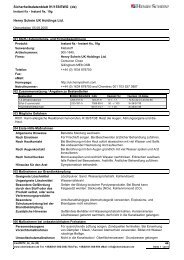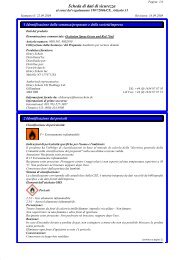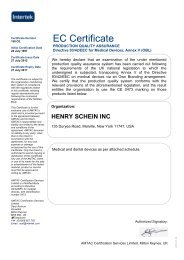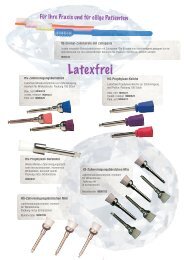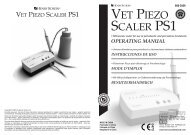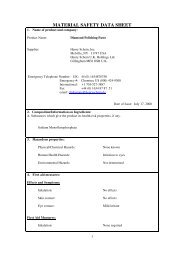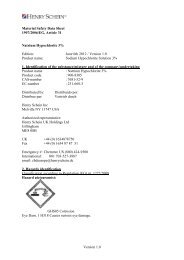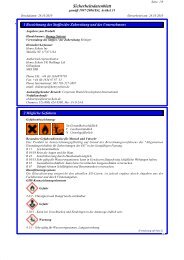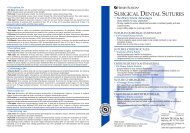Veterinary rapid tests - Henry Schein Corporate Brand
Veterinary rapid tests - Henry Schein Corporate Brand
Veterinary rapid tests - Henry Schein Corporate Brand
Create successful ePaper yourself
Turn your PDF publications into a flip-book with our unique Google optimized e-Paper software.
<strong>Veterinary</strong> <strong>rapid</strong> <strong>tests</strong><br />
Immunochromatographic <strong>rapid</strong> <strong>tests</strong> (also termed Lateral Flow Assays) were originally developed in the<br />
late 1980s as a <strong>rapid</strong> and simple pregnancy test. Since then, this method, which neither needs trained<br />
personnel nor dedicated laboratory equipment, has gained wide acceptance for a variety of point-of-care<br />
and field-use applications in human, veterinary and consumer diagnostics. From now, <strong>Henry</strong> <strong>Schein</strong><br />
private brand is offering a wide range of <strong>Veterinary</strong> <strong>rapid</strong> <strong>tests</strong>. Each test contains 10 sets.<br />
The range includes the following <strong>tests</strong>:<br />
• Feline Leukemia Virus FeLV 9008297<br />
• Feline Immunodeficincy Virus FlV 9008298<br />
• Feline combi - FeLV + FIV 9008299<br />
• Parvovirus – Parvo 9008300<br />
• Borrelia – Ticks 9008301<br />
• Corona 9008302<br />
• Giardiosis - Diarhea 9008303<br />
• 1 •
<strong>Henry</strong> <strong>Schein</strong> Borrelia Test 9008301<br />
BORRELIA ANTIGEN TEST<br />
The Borrelia antigen test is for the direct detection of Borrelia, the causative agent of Lyme borreliosis, in ticks. Lyme<br />
disease is a severe disease that is transmitted by ticks. The causative agent of Lyme disease, Borrelia burgdorferi sensu lato,<br />
is a gram-negative, spiral-shaped and agile bacterium (spirochete). Borrelia cannot survive in the environment. They are dependent<br />
on host organisms. Worldwide at least 13 genospecies belong to the Borrelia burgdorferi sensu lato complex. The<br />
three most important species are B. burgdorferi sensu stricto (Bss), B. garinii (Bg) and B. afzellii (Ba), which also are pathogenic<br />
for humans.<br />
Borrelia are usually transmitted by ticks of the species Ixodes ricinus (common wood tick). In Europe the prevalence of Borrelia<br />
in ticks varies between different regions between 5 to 35%. An increased incidence of tick also differs seasonally, the<br />
so-called "tick season" is during the period from spring to autumn (March - October). In regions with a high prevalence of<br />
ticks animals can be infected with Borrelia several times a year. Ticks also can become infected by Borrelai repeatedly<br />
throughout their development cycle and therefore can also transmit mixed infections of different Borrelia species.<br />
The clinical presentation of Lyme disease in dogs often develops insidiously and is characterized by nonspecific symptoms<br />
such as apathy, lymphadenopathy and intermittent fever. Possible clinical manifestations are caused by infections arthritis<br />
(inflammation) of one or more joints; also some alternating lameness and glomerulopathies (kidney disease) are occasionally<br />
described. In horses, the clinical Lyme disease is broadly discussed. Symptoms such as lameness, joint swelling, neurological<br />
and ocular changes were often observed after experimental infections.<br />
Even with an effective antibiotic therapy is a complete pathogen elimination difficult, especially at a state of an advanced infection.<br />
Early antibiotic treatment is therefore essential for a successful therapy.<br />
What are the benefits of Borrelia antigen test for the veterinarian and pet owner?<br />
The Borrelia antigen test is for the direct detection of Borrelia (B. garinii, B. burgdorferi sensu stricto and B. afzellii)<br />
in the tick.<br />
Ticks can be removed by the patient and directly examined for Borrelia. The result can be documented in the patient records.<br />
The direct detection of Borrelia in the tick and the documentation of a possible positive result in the patient records support<br />
the general diagnosis. At a later date occurring non-specific symptoms, such as fatigue, intermittent fever, or "borreliosis<br />
suspicious" symptoms, such as Joint problems can be better classified in a overall diagnosis and thus a more <strong>rapid</strong> and targeted<br />
therapy, which supports a more favorable prognosis for the patient.<br />
• 2 •
<strong>Henry</strong> <strong>Schein</strong> Borrelia Test 9008301<br />
Rapid test for the direct borrelia test within the tick<br />
• Quick and easy testing<br />
• Reliable proof of borrelia in a tick (B.garinii, B.afzelii and B.burgdorferi sensu stricto)<br />
• Results visible within a few minutes<br />
• Test can be done with all sizes of borrelia<br />
• All required materials are in each test<br />
Sampling<br />
The sampling is of great importance for a meaningful testing. Remove the tick carefully and ensure that the head is also<br />
removed. For this, use tick tweezers (not supplied). Between removal and testing, you can keep the tick in the sample vessel<br />
supplied. Testing can immediately follow removal, but the tick should be tested no later than 2 days after removal. In case it<br />
is a small tick, please add two drops of fluid before crushing.<br />
Attention:<br />
When testing heavily engorged ticks: please add to the sample vessel 3 drops of tick blood and 4 drops of fluid.<br />
TESTING IN THE CASE OF SMALL–MEDIUM-SIZED TICKS<br />
1. Put the tick in the sample vessel, and fill the small tube with 2 drops of fluid.<br />
2. Crush the tick using both ends of the wooden stick.<br />
3. If necessary, add 1–3 more drops of fluid, so that there is enough fluid for testing.<br />
Make sure that the fluid is slightly coloured. If not, the tick has to be crushed further.<br />
4. Add a drop of the tick juice to the test field of the test cassette.<br />
5. Then add two drops of fluid. The fluid will flow up the test strip.<br />
If this stops, a further drop of fluid can be added to the test field.<br />
NB: after the tick has been crushed, the fluid must become slightly coloured.<br />
• 3 •
<strong>Henry</strong> <strong>Schein</strong> Borrelia Test 9008301<br />
TESTING IN THE CASE OF LARGE TICKS<br />
1. Put the engorged tick in the sample vessel.<br />
2. Crush the tick vigorously using the wooden stick (pointed side) provided.<br />
3. Use the pipette (from the test cassette bag) to take up tick juice.<br />
4. Add a drop of the tick juice to the test field of the test cassette.<br />
5. Then add two drops of fluid. The fluid will begin to flow up the test strip.<br />
If this stops, a further drop of fluid can be added to the test field.<br />
NB: the more liquid the tick juice, the better it will flow on the cassette. Thick tick juice can result in slow movement.<br />
ANALYSIS<br />
After 5 minutes, the test can be analysed. One or two red lines appear in the reaction field.<br />
POSITIVE TEST RESULT:<br />
The test line and the control line are visible (i.e. - two lines become visible).<br />
NB: even a faint test line should be interpreted as a positive test result.<br />
NEGATIVE RESULT:<br />
Only the control line is visible.<br />
INVALID:<br />
If no control line is shown, the test is invalid. NB: the maximum time from start to reading the result is 20 minutes.<br />
All results read after 20 minutes are invalid.<br />
STORAGE:<br />
• Protect from moisture<br />
• Store between 4°C and 30°C<br />
• Sampling material should be used on the same day of extracting<br />
• Cassettes should not be frozen<br />
• 4 •
<strong>Henry</strong> <strong>Schein</strong> Corona Test 9008302<br />
PARVOVIRUS / CORONAVIRUS ANTIGEN TESTS<br />
Infection with parvovirus in dogs:<br />
• The canine parvovirus (CPV) infection (parvo) is a highly contagious viral disease found worldwide, which is especially for<br />
unvaccinated dogs, a great and sometimes deadly risk.<br />
• The inclination of the virus to cells with a high division rate affects especially cells in the intestine and thus destroys the<br />
villi completely. The dogs have diarrhea and vomiting; in severe cases bloody diarrhea, low temperature and dehydration.<br />
• Deaths occur mainly in young or unvaccinated dogs.<br />
• With infections of the bone marrow immune cells are infected which leads to a decrease in lymphocytes and leukocytes in<br />
the blood (lympho-and leukopenia). An infection in puppies can cause heart muscle damages.<br />
• The severity of the disease depends on the age of the animals, its immune status, and possible secondary infections, e.g.<br />
with coronaviruses.<br />
• Since the symptoms both of a mild coronavirus, and parvovirus infection of dogs as well as in severe cases of diarrhea<br />
are similar, for suspicions of having a co-infection of coronavirus and parvovirus, a parallel testing of coronavirus is<br />
recommended.<br />
Infections with Parvovirus in cats:<br />
• The Feline parvovirus (FPV) is a trigger for the feline panleukopenia and it occurs especially in puppies that come from<br />
regions where cat populations have an insufficient vaccination. The clinical symptoms are often nonspecific.<br />
• The destruction of the crypt in the intestine leads to enteritis (intestinal inflammation), which only seldom leads to bloody<br />
diarrhea.<br />
• It also can come to an infection of the bone marrow, which leads to a massive decrease of circulating white blood cells<br />
(panleukopenia). This results in an impaired immune response which is characterized by secondary infections.<br />
• The course of disease of Feline Panleukopeie in unprotected puppies is often fatal.<br />
• A specialty of FPV is that it can cross the placental barrier. During pregnancy, it is therefore liable to infect the fetus which<br />
usually leads to the death of the fetus<br />
Infections with coronaviruses in dogs:<br />
• The Feline parvovirus (FPV) is a trigger for the feline panleukopenia and it occurs especially in puppies that come from<br />
regions where cat populations have an insufficient vaccination. The clinical symptoms are often nonspecific.<br />
• The destruction of the crypt in the intestine leads to enteritis (intestinal inflammation), which only seldom leads to bloody<br />
diarrhea.<br />
• It also can come to an infection of the bone marrow, which leads to a massive decrease of circulating white blood cells<br />
(panleukopenia). This results in an impaired immune response which is characterized by secondary infections.<br />
• The course of disease of Feline Panleukopeie in unprotected puppies is often fatal.<br />
• A specialty of FPV is that it can cross the placental barrier. During pregnancy, it is therefore liable to infect the fetus which<br />
usually leads to the death of the fetus<br />
Infections with coronaviruses in dogs:<br />
• The Canine coronavirus (CCV) is widespread in the dog populations and does not generally cause a disease.<br />
• The transmission of coronaviruses occurs for example by mutual sniffing dogs or through the feces of infected animals.<br />
• An infection can cause mild intestinal inflammation. Its importance as a pathogen in dogs is relatively low. Normally the<br />
infections are asymptomatic.<br />
• However, viral shedders can lead to problems in dog breeding. Resulting enteritis can also serve as a precursor of a secondary<br />
infection.<br />
• As symptoms dogs show a few days of vomiting, mushy, foul-smelling diarrhea and slightly elevated body temperature.<br />
• In severe diarrheal events a suspicion of having a secondary infection with parvovirus should always be checked.<br />
• Since both the symptoms of a mild coronavirus and parvovirus infections in dogs are similar, as also in severe cases of<br />
diarrhea a possible co-infection of coronavirus and parvovirus can be suspected, therefore a combined diagnosis with<br />
parvoviruses is recommended.<br />
• 5 •
<strong>Henry</strong> <strong>Schein</strong> Corona Test 9008302<br />
Infections with coronaviruses in cats:<br />
• coronaviruses can cause slimy intestinal infections in cats or in rare cases, a feline infectious peritonitis (FIP)<br />
• The infection with feline coronavirus (FCoV) often is oronasal. The viruses are excreted in the feces from cats with a FCoV<br />
intestinal infection or from cats with a FIP (feline infectious peritonitis) infection.<br />
• Infections with FCoV destroy the villi which lead to an intestinal infection with fever. Subsequently a persistent intestinal<br />
infection of cats may occur. These animals shed the virus intermittently (linear manner with interruptions) for several<br />
months or even a lifetime without showing clinical symptoms themselves and provide a permanent source of infection<br />
for other cats dar.<br />
• Generally it should be made a differentiation between a FCoV and FIP infection, because not every infection with feline<br />
coronavirus leads to a feline infectious peritonitis (FIP). A FIP can develop in infected cats with coronavirus. It develops<br />
when the replication of the virus in the host causes a mutation in the virus genome.<br />
• Particularly young or immunosuppressed cats are affected. About 50% of with a FIP infected animals are younger than<br />
12 months, 70% are younger than 4 years.<br />
• The appearance of a FIP disease is varied and often nonspecific.<br />
• Therefore, in cats with recurrent fever, chronic weight loss, organ changes of unknown origin and antibiotic-resistant<br />
therapy trials, as well as in all cats with effusions into body cavities, the presumptive diagnosis of FIP can be made.<br />
For prognostic reasons and to avoid a possibly long ordeal of cats, a fast diagnosis is crucial.<br />
• The Canine coronavirus (CCV) is closely associated with the feline coronavirus (FCoV) and it is also infectious for<br />
cats can cause feline enteritis, a Feline infectious peritonitis (FIP).<br />
• Recent studies have shown that some isolates represent the feline infectious peritonitis virus are the recombinant<br />
of canine corona virus and feline coronavirus.<br />
Why is a joint detection of parvo and corona viruses in dogs and cats possible?<br />
The canine coronavirus (CCV) and the feline coronavirus (FCoV), as well as the canine parvovirus (CPV) and the feline<br />
parvovirus (FPV) are similar in 99% of their DNA structure (genome).<br />
Why makes a simultaneous detection of parvo and corona viruses in dogs and cats sense?<br />
• The simultaneous detection of parvo and corona viruses in dogs and cats makes sense, because the symptoms of a<br />
mild coronavirus and parvovirus infection are often very similar.<br />
• A simultaneous infection with both pathogens can lead to very severe and fatal disease progressions. For the<br />
therapeutic approach and prognosis the diagnosis oft he specific pathogen is important.<br />
• A fecal examination makes sense to distinguish a CCV infection in dogs from other causes of diarrhea and to identify<br />
clinically unapparent CCV shedders, especially in large households with larger cats or dogs husbandries<br />
• The Canine coronavirus (CCV) is closely related with the feline coronavirus (FCoV) and also infectious for cats.<br />
CCV can cause enteritis in cats.<br />
• The fecal examination makes sense for cats to distinguish a FCoV infection from other causes of diarrhea or to identify<br />
clinically unapparent FCoV shedders.<br />
• Each new animal to an existing cat population should be tested on existing FCoV antigens. So FCoV shedders can<br />
be detected and possibly separated.<br />
To consider in case of a negative test result:<br />
Viruses are always excreted intermittently, so that in case of a negative test result in suspected cases a repeat test<br />
should be performed.<br />
To be observed in case of positive test results:<br />
• Dogs and cats are vaccinated for protection against parvovirus with live attenuated vaccines.<br />
This vaccination can interfere up to 12 days after the vaccination with the test results and may give false positive results.<br />
• A positive coronavirus antigen test in cats indicates the presence of coronaviruses, but only for 1-5% of cats with feline<br />
coronavirus infection develop later a FIP<br />
• 6 •
<strong>Henry</strong> <strong>Schein</strong> Corona Test 9008302<br />
Reliable <strong>rapid</strong> test for the suspicion of canine corona virus<br />
• User-friendly<br />
• Immediate on-site diagnostics<br />
• Quick results visible within few minutes<br />
• No extra materials needed<br />
Sampling:<br />
Due to the practical test tube sampling on site<br />
is much less complicated and can be easily carried<br />
out under hygienic conditions.<br />
TESTING<br />
Take a stool sample using the cotton bud provided. Make sure that the upper end of the cotton bud is covered. Unscrew the<br />
test tube and place the cotton bud with the stool inside. Swirl the bud around in the fluid several times, so that the sample<br />
material becomes loose. Screw the test tube shut. Agitate vigorously to mix the contents until the fluid discolours. Break<br />
the pipette seal of the test tube by applying sharp pressure. Open the test cassette packaging and place the cassette on a<br />
horizontal surface. By applying gentle pressure, you can apply three drops of the sample material to the test field of the test<br />
cassette. If, after the first three drops, the fluid has not yet started to flow across the test strips, add a further drop.<br />
ANALYSIS<br />
After few minutes, the test can be analysed. One or two red lines appear in the reaction field.<br />
POSITIVE TEST RESULT:<br />
The test line and the control line are visible (I.e. two lines become visible).<br />
NB: even a faint test line should be interpreted as a positive test result.<br />
NEGATIVE RESULT:<br />
Only the control line is visible.<br />
INVALID:<br />
If no control line is shown, the test is invalid. NB: the maximum time from start to reading the result is 20 minutes.<br />
All results read after 20 minutes are invalid.<br />
Storage:<br />
• Protect from moisture<br />
• Store between 4°C and 30°C<br />
• Cassettes should not be frozen<br />
• The samples can be cooled between 2-8°C for up to two days and stored at -20°C for several days<br />
• 7 •
<strong>Henry</strong> <strong>Schein</strong> Parvo Test 9008300<br />
Reliable <strong>rapid</strong> test is used for parvovirus (CPV and FPV) antigen stool samples<br />
• User-friendly<br />
• Immediate on-site diagnostics<br />
• Quick results visible within few minutes<br />
• No extra materials needed<br />
Sampling:<br />
Due to the practical test tube sampling on site<br />
is much less complicated and can be easily<br />
done under hygienic conditions.<br />
TESTING<br />
Take a stool sample using the cotton bud provided. Make sure that the upper end of the cotton bud is covered. Unscrew the<br />
test tube and place the cotton bud with the stool inside. Swirl the bud around in the fluid several times, so that the sample<br />
material becomes loose. Screw the test tube shut. Agitate vigorously to mix the contents until the fluid discolours. Break<br />
the pipette seal of the test tube by applying sharp pressure. Open the test cassette packaging and place the cassette on a<br />
horizontal surface. By applying gentle pressure, you can apply three drops of the sample material to the test field of the test<br />
cassette. If, after the first three drops, the fluid has not yet started to flow across the test strips, add a further drop.<br />
ANALYSIS<br />
After few minutes, the test can be analysed. One or two red lines appear in the reaction field.<br />
POSITIVE TEST RESULT:<br />
The test line and the control line is visible (i.e - two lines become visible).<br />
NB: even a faint test line should be interpreted as a positive test result.<br />
NEGATIVE RESULT:<br />
Only the control line is visible.<br />
INVALID:<br />
If no control line is shown, the test is invalid. NB: the maximum time from start to reading the result is 20 minutes.<br />
All results read after 20 minutes are invalid.<br />
Storage:<br />
• Protect from moisture<br />
• Storage between 4°C and 30°C<br />
• Cassettes should not be frozen<br />
• The samples can be cooled between 2-8°C for up to two days and stored at -20°C for several days<br />
• 8 •
<strong>Henry</strong> <strong>Schein</strong> FeLV – FIV – FeLV & TIV Test<br />
9008297 – 9008298 - 9008299<br />
FIV ANTIBODY TEST<br />
The feline immunodeficiency virus infection (FIV) is caused by the feline immunodeficiency virus, a retrovirus that belongs<br />
to the subfamily of lentiviruses. It is an RNA virus. FIV is a common viral disease in cats, which damages the immune system.<br />
The disease pattern are usually caused by secondary infections (fever, anorexia, lymphadenopathy) and not caused by the<br />
virus itself. In addition to these symptoms mainly stomatitis (inflammation of the oral mucosa), neurological deficits and an<br />
increased tumor tendency are possible symptoms. The incubation time after an infection can be different for each animal.<br />
Some cats may experience the first symptoms a few days after an infection, for other animalsthis may take weeks, months<br />
or sometimes years.<br />
An infection occurs primarily through bite wounds. Therefore all free-range, non-neutered male cats belong to the primer<br />
"risk group" (ranking battles). FIV occurs rather seldom with cats which only live indoor.<br />
With the FIV antibody test existing antibodies against the virus-specific proteins of FIV are detected. Usually already after<br />
two to four weeks after an infection a measurable antibody level is reached, so that the antibody test can be used. It is important<br />
to know, that after a direct infection or in the late course of the disease, after the collapse of the immune system, antibodies<br />
are barely detectable.<br />
Which cats should be tested with FIV antibody test?<br />
• Any sick cat with chronic, persistent or recurrent infection of unknown origin should be tested for an existing FIV<br />
infection, as this influences both the prognosis, the applied therapeutic measures and how the animals are kept.<br />
• Each new cat in an existing cat population should be tested for present FIV antibodies.<br />
• The FIV status of every cat should be known be tested routinely (annually for free-range cats).<br />
Possible test results / test interpretation for a FIV antibody test:<br />
A negative antibody test result may<br />
• be from a non-infected cat<br />
• or from an infected cat in the early phase of a FIV infection (up to 2 weeks p. Inf.), when still not enough antibodies have<br />
been formed<br />
• or from a cat in the final stages of the disease when the concentration of antibodies in the blood falls below the detection<br />
limit due to high immune suppression.<br />
A positive antibody test result cat<br />
• can be from an infected cat<br />
• or from a kitten, up to the age of 6 months with maternal antibodies. These puppies are usually not affected,<br />
because FIV is rarely transmitted in utero. Nevertheless a test should be repeated at a later stage.<br />
The aim of therapy is always:<br />
• to strengthen the immune system and prevent further infections. A curative therapy is not possible. Currently not approved<br />
vaccine against FIV is available in the EU<br />
• For a FIV-infected cat a semi-annual "health check" should be performed to detect clinical changes in time and to treat<br />
them symptomatically.<br />
• FIV-infected cats should be kept indoors or free-range cats should be neutered (to avoid rank fighting), and also the cats<br />
regularly wormed and vaccinated to prevent additional infections and infections of other own cats.<br />
• 9 •
<strong>Henry</strong> <strong>Schein</strong> FeLV – FIV – FeLV & TIV Test<br />
9008297 – 9008298 - 9008299<br />
FELV ANTIGEN TEST<br />
The feline leukemia virus infection is caused by the feline immunodeficiency virus, a retrovirus. FeLV is a common viral<br />
disease in cats, which damages the immune system.<br />
Transmission: The excretion of FeLV occurs primarily in the saliva of infected cats, the most transmission is primarily oronasal<br />
by sniffing, mutual grooming, or in joint dropping and feeding grounds. Also, a placental (via the placenta away) infection<br />
is possible. The course of the disease varies greatly and is dependent both on the immune status of the cat, as well<br />
as their risk of infection. Young cats are more susceptible than older cats and also more likely develop a persistent viremia<br />
(presence of the virus).<br />
The infection proceeds in several phases, rarely all phases pass up to the persistent viremia. The course of the disease depends<br />
on the immune status of the cat. Most of the infected animals stop the infection 3-16 weeks post infection and develop<br />
in this time a transient viremia. Is the immune response of the cat not sufficient to eliminate the pathogens the cat<br />
remains persistently viremic, thus is a life "shedder."<br />
A FeLV infection may be present for a long time without symptoms. The disease patterns are diverse and a diagnosis based<br />
on the clinical picture is hardly possible. The disease can be divided into primary infection symptoms, that are directly a result<br />
of the viral infection, and secondary infection symptoms.<br />
The diagnosis of a FeLV infection (viremia) can be performed with the FeLV antigen test by the detection of FeLV antigens in<br />
the peripheral blood. The antigen detection is possible about 3 weeks after infection.<br />
Which cats should be tested with the FeLV antigen test?<br />
• Any sick cat with chronic, persistent or recurrent infection of unknown origin should be tested for FeLV-existing (or FIV),<br />
as this influences both the prognosis and the therapeutic measures.<br />
• Each new cat in a cat population should be tested for FeLV-existing antigens (and/or FIV antibodies).<br />
• The FeLV (and FIV) status for every cat should be known and can be identified routinely (annually for free-range cats) and<br />
before vaccinations.<br />
• For a FeLV infection, there is no "real" treatment option. Therefore, prevention is very important.<br />
• 10 •
<strong>Henry</strong> <strong>Schein</strong> FeLV – FIV – FeLV & TIV Test<br />
9008297 – 9008298 - 9008299<br />
Possible test results / interpretations:<br />
A one-time positive FeLV antigen test result can be from a cat<br />
• with transient viremia<br />
• or from a cat with persistent viremia.<br />
• In order to distinguish a transient viremia from a persistent one, a new test should be performed after 6 weeks, then if still<br />
positive, another one after another 10 weeks.<br />
A negative FeLV antigen test result can be from a<br />
• non-infected cat<br />
• latently infected cat<br />
• cat in the first three weeks of a FeLV infection. Therefore, the test should be repeated at a later stage.<br />
FIV antibody-FeLV antigen combined testt<br />
The FeLFIV combined test is for the <strong>rapid</strong> and reliable detection of feline (FeLV p27) antigen and the detection of antibodies<br />
against feline immunodeficiency virus (FIV) in whole blood, serum or plasma of cats. The combined <strong>rapid</strong> test for the detection<br />
of FeLV (antigen) and FIV (antibodies) can be routinely performed with a blood sample (blood, plasma or serum).<br />
The symptoms of a FeLV / FIV infection are mostly (75%) due to secondary infections (fever, anorexia, lymphadenopathy)<br />
and not caused by the virus itself. Therefore for a chronic, treatment-resistant disease of unknown origin, for the differential<br />
diagnosis a FeLV or FIV infection should always be considered.<br />
FIV<br />
Virus Lentivirus Onkovirus<br />
Disease Feline immunodeficiency Feline leukemia virus infection<br />
“Cats HIV“<br />
„Leukosis“<br />
Risk group unneutered free running male cat Young cats, multi-cat households and<br />
for pure indoor cats seldom<br />
free runners<br />
FeLV<br />
Transmission Primarily through a bite Close contact<br />
Prevalence Clinically healthy 2-3% Clinically healthy 2-3%<br />
Clinically ill: 13-19% Clinically ill: 11-17%<br />
Immunosuppressant often often<br />
Diagnosis (routine) Antibody detection Antibody detection<br />
Prophylaxis Vaccination (only in the USA) Vaccination<br />
Prognosis Life expectancy is not reduced, 85% of persistently infected cats die<br />
can live for years<br />
within 3-5 years<br />
without symptoms<br />
Symptoms: Stomatitis, neurological symptoms, Immune-mediated diseases,<br />
immune-mediated diseases, secondary infections, aplastic anemia<br />
secondary infections, increased<br />
reproductive disorders,<br />
tumor incidence<br />
fading kitten syndrome<br />
• 11 •
<strong>Henry</strong> <strong>Schein</strong> FeLV – FIV – FeLV & TIV Test<br />
9008297 – 9008298 - 9008299<br />
Reliable <strong>rapid</strong> test for determination of FeLV and FIV in blood, plasma and serum<br />
Available as a combi test (9008299) and two separate single <strong>tests</strong> (9008297 and 9008298)<br />
• User-friendly and reliable<br />
• on-site diagnostics within few minutes<br />
• can be used with full blood, serum or plasma<br />
HANDLING THE SAMPLE<br />
Do not keep the samples at room temperature for too long. Serum and plasma can be stored between 2–8°C for up to<br />
3 days. For longer storage, the samples should be frozen at below -20°C. Venous full blood should be stored between<br />
2–8°C, if the test is due to be carried out within 2 days from sampling. Do not freeze full blood samples. If samples are<br />
being shipped somewhere, they should be packed in accordance with local regulations concerning aetiological agents.<br />
Bring the samples to room temperature before testing.Frozen samples must be fully thawed before testing and mixed well.<br />
Samples should not be refrozen and re-thawed.<br />
General instructions for the use of blood samples:<br />
Separate the serum or plasma as <strong>rapid</strong>ly as possible from the blood, to avoid haemolysis Heparin blood and EDTA blood can be<br />
used to extract plasma. Only use clear rather than haemolysed samples. Testing should take place immediately after sampling<br />
TESTING IN THE CASE OF SERUM AND PLASMA<br />
1. Take blood from the cat and extract the serum or plasma. Using the pipette from the test cassette pouch,<br />
take up the sample material obtained. Add a drop of the sample material to the two test fields. Let the sample<br />
material soak in for a few seconds.<br />
2. Open the reagent vial and add two drops to each of the test fields. The fluid begins to flow up the test strip. If the fluid<br />
does not begin to flow up after a few seconds, add a further drop to the reagent vial.<br />
3. Add three drops of the mixtures to each of the test fields. If the fluid does not begin to flow up after a few seconds,<br />
add a further drop of fluid.<br />
• 12 •
<strong>Henry</strong> <strong>Schein</strong> FeLV – FIV – FeLV & TIV Test<br />
9008297 – 9008298 - 9008299<br />
TESTING FULL BLOOD<br />
1. Take blood from the cat. Using the pipette, supplied in the test cassette pouch, take up the full blood obtained immediately<br />
and add 2 drops to the sample vessel supplied. Then open the reagent vial and add a total of 6 drops of fluid.<br />
2. Close the sample vessel and shake well. Re-open and take up enough sample material using the pipette.<br />
3. Add three drops of the mixtures to each of the test fields. If the fluid does not begin to flow up after a few seconds,<br />
add a further drop of fluid.<br />
ANALYSIS<br />
After 5 minutes, the test can be analysed. One or two red lines appear in the reaction field.<br />
POSITIVE TEST RESULT:<br />
The test line and the control line are visible (i.e. two lines become visible).<br />
NB: even a faint test line should be interpreted as a positive test result.<br />
NEGATIVE RESULT:<br />
Only the control line is visible.<br />
INVALID:<br />
If no control line is shown, the test is invalid. NB: the maximum time from start to reading the result is 20 minutes.<br />
All results read after 20 minutes are invalid.<br />
Storage:<br />
• Protect from moisture<br />
• Storage between 4°C and 30°C<br />
• Cassettes should not be frozen<br />
• Sampling material should be used on the same day of extracting<br />
• 13 •
<strong>Henry</strong> <strong>Schein</strong> Giardia Test 9008303<br />
Giardia antigen test<br />
Giardiasis is a worldwide occurring, with a usually clinically latent course, parasitic intestinal disease with different severities<br />
in dogs and cats. A clinically manifestation of the giardiasis occurs mainly in young animals. Giardia is besides nematodes<br />
(roundworms), the most common Endoparasitose in cats and dogs. A giardiasis is caused by Giardia duodenalis (syn. Giardia<br />
lamblia, Giardia intestinalis).<br />
The pathogen is one of the single-celled intestinal parasites (protozoa, flagellates). Its life cycle has two distinct forms of parasites,<br />
the moving and viable trophozoites, settle in the small intestine of infected animals, and the against environmental<br />
influences highly resistant cysts (high tenacity). The cysts develop in the small intestine of dogs and cats and are excreted in<br />
the feces. Dogs and cats become infected by direct uptake of infectious cysts by licking, through drinking with cysts contaminated<br />
water or contaminated food. Giardia cysts are infectious for up to 3 weeks in cool water up to 3 months in the outside<br />
world and also in feces-soiled fur and skin of animals.<br />
10 cysts are enough to cause an infection. After an oral intake the cysts develop in the small intestine to the moving, viable<br />
trophozoites. These attach to the mucosal surface of the small intestine. These destroy the intestine surface which leads to a<br />
malabsorption (decreased absorption of important nutrients), catarrhal diarrhea and bacterial secondary infections. In Giardia,<br />
the prepatent period, i.e. the onset of infectious cysts in the feces after oral uptake, is 4-10 days. Excretion occurs intermittently,<br />
not with every defecation.<br />
The prevalence of Giardia in dogs and cats e.g. in Germany is 26.8% and 18.7%. The problem of giardiasis is the high tenacity<br />
(survivability) of the cysts. Especially in larger breeds, animal shelters or kennels reinfection is almost inevitable. Therefore,<br />
the focus in the fight against giardiasis lays in the detection of clinically healthy shedders, its treatment and a thorough<br />
disinfection of environment with effective products.<br />
Giardia antigen test<br />
The Giardia antigen test is an immunochromatographic <strong>rapid</strong> test for detection of Giardia-specific antigens, the cysts and<br />
trophozoites in the fecal material. The test is validated for dogs and cats.<br />
When should the Giardia antigen test be used, what's important?<br />
The Giardia antigen test should always be performed with chronic recurrent, intractable diarrhea of unclear origin in dogs<br />
and cats, especially when puppies and kittens are affected.<br />
The Giardia antigen test is suitable as a screening tool for monitoring the hygiene management after remediation of problematic<br />
dog and cat husbandries. For this collective or individual fecal samples can be examined for Giardia.<br />
The Giardia antigen test could be carried out prophylactically to protect new entrants into an existing husbandry, since animals<br />
are often asymptomatic carriers. Important note: Due to the intermittent excretion of cysts, which vary greatly in their<br />
intensity and temporarily suspend, always 3 different fecal samples (also pooled feces samples) over a period of three to ten<br />
days should be tested.<br />
It should also always be remembered that Giardia are zoonotic. Therefore small children and people with immunosuppressive<br />
diseases, having close contact with the animals, are at risk of an infection.<br />
• 14 •
<strong>Henry</strong> <strong>Schein</strong> Giardia Test 9008303<br />
The reliable <strong>rapid</strong> test is used for Giardia antigen stool samples<br />
• User-friendly<br />
• Immediate on-site diagnostics<br />
• Quick results visible within few minutes<br />
• No extra materials needed<br />
Sampling:<br />
Due to the practical test tube sampling on site<br />
is much less complicated and can be easily carried<br />
out under hygienic conditions.<br />
TESTING<br />
Take a stool sample using the cotton bud provided. Make sure that the upper end of the cotton bud is covered. Unscrew the<br />
test tube and place the cotton bud with the stool inside. Swirl the bud around in the fluid several times, so that the sample<br />
material becomes loose. Screw the test tube shut. Agitate vigorously to mix the contents until the fluid discolours. Break<br />
the pipette seal of the test tube by applying sharp pressure. Open the test cassette packaging and place the cassette on a<br />
horizontal surface. By applying gentle pressure, you can apply three drops of the sample material to the test field of the test<br />
cassette. If, after the first three drops, the fluid has not yet started to flow across the test strips, add a further drop.<br />
ANALYSIS<br />
After few minutes, the test can be analysed. One or two red lines appear in the reaction field.<br />
POSITIVE TEST RESULT:<br />
The test line and the control line is visible (i.e - two lines become visible).<br />
NB: even a faint test line should be interpreted as a positive test result.<br />
NEGATIVE RESULT:<br />
Only the control line is visible.<br />
INVALID:<br />
If no control line is shown, the test is invalid. NB: the maximum time from start to reading the results is 20 minutes.<br />
All results read after 20 minutes are invalid.<br />
Storage:<br />
• Protect from moisture<br />
• Storage between 4°C and 30°C<br />
• Cassettes should not be frozen<br />
• The samples can be cooled between 2-8°C for up to two days and stored at -20°C for several days<br />
• 15 •
Advantages of the products<br />
Shelf-life:<br />
1. The products have a general shelf-life of 18 month (24 month for all but FelV and FIV Test).<br />
2. The Snap-Tests have a general shelf-life of 6 month.<br />
Storage:<br />
1. The <strong>tests</strong> can be stored at room temperature.<br />
2. The Snap-Tests have to be stored in a refrigerator.<br />
Application:<br />
1. The <strong>tests</strong> can be used instantly.<br />
2. The Snap-Tests have to acclimate to room temperature for 30 minutes.<br />
3. The <strong>tests</strong> are very silent. The „Snap“ of the snap-<strong>tests</strong> can disturb already agitated cats.<br />
Price:<br />
1. The <strong>tests</strong> are far more favorable price compared to Snap-Tests.<br />
2. This does especially help when using Giardia-Tests, since those have to be used several times in the diagnosis.<br />
• 16 •



